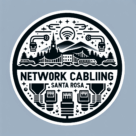What Is the Most Common Type of Network Cabling? A Complete Guide
When setting up a network — whether for your home, office, or business — one of the most important decisions you’ll make is choosing the right cabling. Network cabling is the backbone of your internet and data infrastructure. But with so many types available, you might wonder: what is the most common type of network cabling used today?
Let’s break it down in simple terms and help you understand which option is best for your needs. Our team of structured cabling professionals in Santa Rosa delivers reliable network installations designed for speed, safety, and long-term performance.
The Most Common Type of Network Cabling: Ethernet (CAT5e and CAT6)
The most widely used network cabling today is Ethernet cabling, specifically CAT5e and CAT6 cables. These cables are part of the twisted-pair cable family, which use copper wiring to transmit data between computers, routers, switches, and other devices.
Here’s a quick overview of each:
- CAT5e (Category 5 Enhanced):
The standard for most small offices and homes, supporting speeds up to 1 Gbps. It’s affordable, easy to install, and reliable for general internet use. - CAT6 (Category 6):
The preferred choice for businesses and new installations. It supports speeds up to 10 Gbps and offers better performance over longer distances with less interference.
Because of their balance between cost, performance, and compatibility, CAT5e and CAT6 Ethernet cables remain the most common network cabling types in the world.
Why Ethernet Cabling Is So Popular
Ethernet cabling dominates the networking world for several reasons:
- High Speed and Reliability – Ethernet cables provide consistent data transmission without the signal loss you often see in wireless networks.
- Cost-Effective – Copper-based Ethernet cables are affordable and easy to replace or upgrade.
- Scalability – Easy to expand and adapt to new devices or future technology.
- Versatility – Suitable for homes, offices, data centers, and industrial environments.
- Ease of Installation – Most Ethernet cabling can be installed quickly, and termination tools are readily available.
Whether you’re streaming, video conferencing, or running cloud-based applications, Ethernet cabling provides a dependable connection that wireless systems can’t always guarantee.
Other Common Types of Network Cabling
While Ethernet is the most common, there are several other cabling types worth knowing about — each suited for specific applications:
1. Fiber Optic Cabling
Fiber optic cables use glass strands to transmit data as light signals. They’re known for extremely high speed, long-distance performance, and resistance to electromagnetic interference.
- Best for: Data centers, large campuses, and ISPs
- Speeds: Up to 100 Gbps and beyond
2. Coaxial Cabling
Once popular for TV and early internet, coaxial cables are still used in some broadband and CCTV systems.
- Best for: Cable internet, video surveillance
- Speeds: Up to 1 Gbps (depending on provider and setup)
3. Shielded Twisted Pair (STP)
STP cables have additional shielding to protect against interference, making them ideal for environments with high electrical noise.
- Best for: Industrial and manufacturing facilities
4. Unshielded Twisted Pair (UTP)
The most common Ethernet type (like CAT5e and CAT6) — lightweight, flexible, and widely used in both residential and commercial setups.
Choosing the Right Network Cabling for Your Needs
When deciding which type of cabling is best for your network, consider:
- Speed requirements (1 Gbps, 10 Gbps, or higher)
- Distance between devices
- Environment (office, factory, or outdoor installation)
- Budget for materials and labor
- Future expansion and technology upgrades
For most applications, CAT6 Ethernet cabling strikes the perfect balance between cost, performance, and longevity — making it the go-to choice for many California homes and businesses.
The Future of Network Cabling
As technology evolves, so does network infrastructure. Fiber optic cabling continues to grow in popularity for large-scale and high-speed networks, while CAT6a and CAT7 cables are becoming more common for future-proof installations.
Still, Ethernet cabling remains the standard — reliable, affordable, and adaptable to both current and future demands. Network cables play a vital role beyond individual setups — discover how significant network cabling is in the community and its impact on communication systems.
Final Thoughts
So, what is the most common type of network cabling?
In today’s connected world, Ethernet cabling — particularly CAT5e and CAT6 — remains the top choice for most installations. It offers the ideal mix of performance, affordability, and reliability, whether for home use or complex business networks.
If you’re planning a new installation or upgrade, talk to a certified network cabling installer to determine the best setup for your space and future needs.
